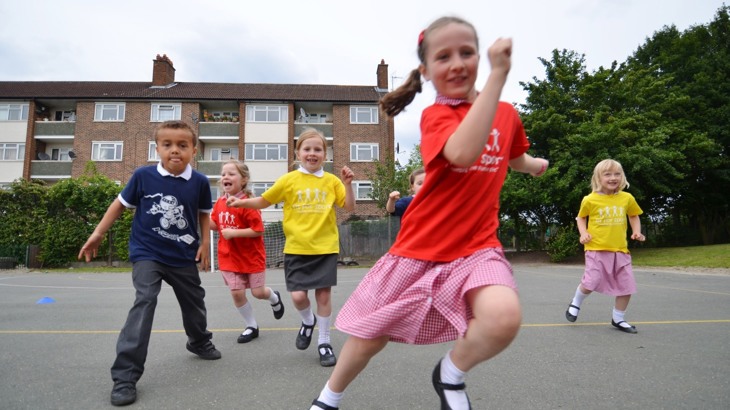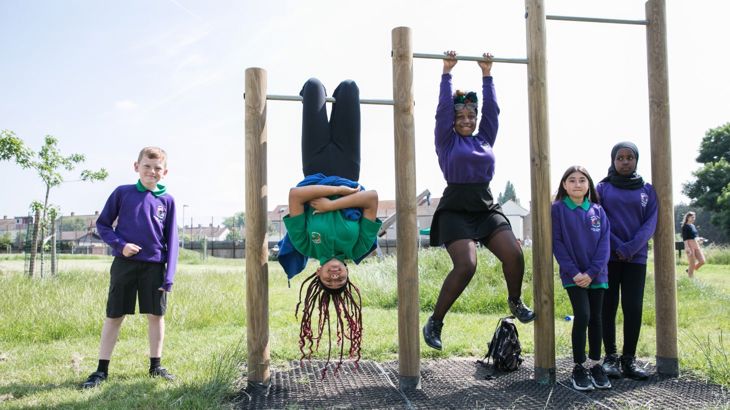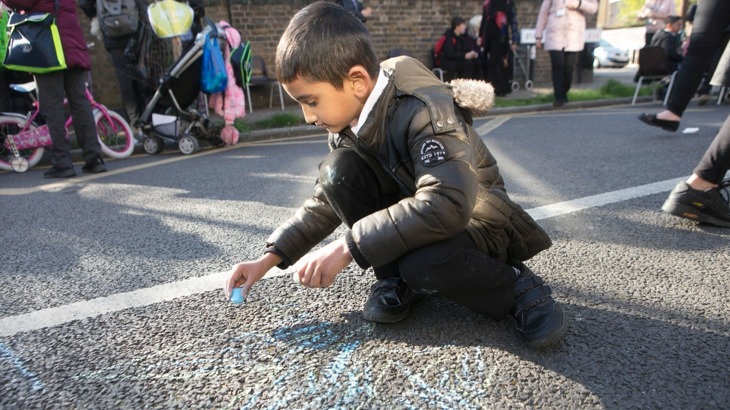A truly inclusive and accessible city must take children's needs into account. Our blog examines recent research on the benefits of 20-minute neighbourhoods for children's mental and physical wellbeing, as well as why their needs and wants should be considered.

Children need to feel safe in their neighbourhoods. ©Sustrans
What is a 20-minute neighbourhood?
In a 20-minute neighbourhood, you can walk to most of what you need in 20 minutes.
Essentially, this would roughly be an 800m diameter circle with a high density of buildings and streets, no severance from major roads, rivers, or railways, and various amenities such as schools, shops, health care facilities, etc.
Twenty-minute neighbourhoods can improve liveability and increase activity from walking and cycling by reducing the need for car travel, as well as contributing towards net zero ambitions.
Designing streets with children and other vulnerable groups in mind
Currently, policies and guidance rarely consider the needs of children in these neighbourhoods beyond the provision of playparks and schools, yet nearly a fifth of UK citizens are children.
When we design our neighbourhoods to meet the needs of children, we also meet the needs of other vulnerable groups and those with limited mobility, but perhaps not everyone.
There is limited evidence about how child-friendly designs affect those with visual impairments, for example.
The child population is not homogeneous
Children are diverse and it is vital to consider all ages and stages, from newborns and their carers to teenagers.
NACTO's guidance provides a good overview of streetscape needs at different stages.
Whether it be frequent places for young children to stop and rest or good public transport links for older children to get around independently.
Children have a right to express their views on matters that affect them
Consulting with children can provide new perspectives, highlight their differing needs and potentially increase the use of the outputs.
Consultation techniques vary by age but can include drawing, modelling, guided walks, photography or the ‘photovoice’ method, dialogue, writing, and so on.
Observing children at play can reveal things dialogue may not, and helps to highlight when objects are used unexpectedly.

Children play outdoors. ©2021, Kois Miah, all rights reserved
Children's needs
What children need from their neighbourhood falls into 8 broad categories: housing, opportunities for exercise, play, natural elements, social interaction, safety (traffic and social), good air quality, and education or learning environments.
Across all age groups, children are asking for the same things that we have identified are needed, such as:
- playgrounds
- nature
- shops, mainly food shops
- playing fields
- places to socialise (such as friends’ houses)
- cleanliness (in respect of litter)
- opportunities for risk-taking
- and safety features such as lighting and low or no traffic.
Younger children also identified features used by older family members, showing an understanding of the needs of others.
Housing, physical activity and play
Children’s housing should ideally have access to outdoor space and a room for each child, with a lift in apartment buildings.
Physical activity is beneficial for both physical and mental health.
Luckily, children’s physical activity can be increased simply by ensuring there are safe, accessible places to play and move.
Children are more likely to be physically active if they are outdoors, during unstructured activity, and if they have walked to an activity.
Park space and multi-use paths can also support physical activity.
Outdoor play and risky play are important for growth, development and physical activity.
Well-designed playgrounds offer a safe environment and play equipment not found elsewhere.
Older children also need space to play (such as cooperative swings, sports areas, zip lines, and so on).
However, play doesn’t have to be confined to a playground and opportunities for play can arise anywhere within a city, from vacant lots to bus stops.

Social contact and interaction are vital for healthy child development. ©2019, Hitherfield School, All Rights Reserved.
Social contact and interaction are vital for healthy child development
In one study, children referred to important places in their neighbourhood by the people they meet at these places, rather than the physical features.
This shows the importance of these interactions on how they view and interact with their space.
As children grow, their social interaction needs change, from interacting with caregivers to spending more time with peers.
For adolescents, peer-to-peer social interaction provides informal social support and promotes wellbeing.
Youth needs can be met through hang-out spaces, with Wi-Fi or in nature, opportunities for play and risk-taking, and affordable restaurants, all of which teenagers request.

Youth needs can be met through hang-out spaces. ©Chandra Prasad.
The provision of physical and social safety to children
Keeping children safe from traffic is especially important since traffic fears reduce their independence and ability to move independently.
Solutions can include pedestrianisation, low-traffic neighbourhoods, school streets and play streets.
Children undertake normal activities, such as cycling and playing, within the road environment, so removing children from the road is not a solution.
Instead, focus on removing or reducing traffic in spaces where children spend time.
Social safety is also important for allowing children to travel independently.
A sense of safety in public places can be achieved through 'natural surveillance', walkable neighbourhoods, and a fostering community.
And providing facilities and places for older children can help prevent crime among this age group.
Because children are lower to the ground where pollutants are concentrated and growing, good air quality is especially important for them.
By limiting traffic levels, not only physical safety but also pollution levels can be improved.

Children playing on climbing frame. ©2021, Sustrans, all rights reserved.
Education extends beyond schools
Over 60% of parents of secondary school-age children in England choose to send their children not to the closest school, but to the one with the highest attainment.
Outside of schools, children need safe, exciting and stimulating environments to learn through play.
Using artwork, paving patterns and games, natural areas, and landscaping can enrich a child's senses and foster positive learning experiences outside the classroom.
The presence of poor quality or unhealthy food is associated with unhealthy eating habits and obesity.
With the help of local fast food suppliers, London's 'School Superzones' provided healthier options and reduced advertising around schools, while promoting active travel, helping to reduce crime, and reducing traffic-based air pollution.
However, having all the features and facilities children need readily available is useless if they cannot get to them safely and comfortably.

School Streets provide a safe environment for children to play. ©2019, Tower Hamlets, All Rights Reserved
Children can’t roam as widely or walk as far as adults
Evidence is limited, but some sources suggest roughly 800m, or one kilometre for school travel.
Thankfully, this lines up with the radius of a 20-minute neighbourhood, that we discussed earlier.
Safe, segregated cycle lanes and good public transport links can help children, particularly older children, travel further.
Allowing children to get around independently provides opportunities for healthy social and physical development, the freedom to access the natural environment, and prepares them for independent life as adults.
Creating safer, more walkable neighbourhoods can help increase children’s independent mobility by reducing safety fears for both caregiver and child.
A city that goes beyond child-friendly
In conclusion, children want the same things from their neighbourhood as everyone else.
The key differences are in how those needs are met, how accessible and how close to home they are.
Keeping their neighbourhood safe from traffic and social fear is especially important.
A child-friendly design covers a wide range of needs and abilities, but for a city to be truly inclusive, we must consider the needs of all individuals.

Download the full report
This article's findings are based on an extensive literature review conducted by our team on the existing literature, as detailed in the full report.





